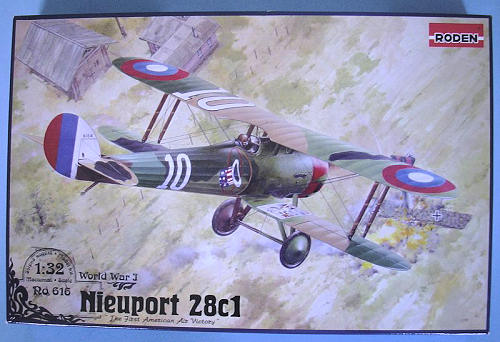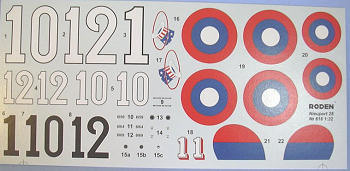
| KIT: | Roden 1/32 Nieuport 28 |
| KIT #: | 616 |
| PRICE: | $64.99 MSRP |
| DECALS: | Three options |
| REVIEWER: | Tom Cleaver |
| NOTES: |

| HISTORY |
The Nieuport line was established with the Nieuport 10, a light-weight, rotary-powered airplane with sesquiplane layout, which was defined with the Nieuport 11 "Bebe." Appearing in late 1915, it did much to end the "Fokker Scourge" in early 1916. The design became "classic" with the Nieuport 17, the mount of such aces as Guynemer, Nungesser, Ball and Bishop in 1916-17. By late 1917 it was obvious the design had seen better days. The heavier and faster SPAD VII and later XIII paved the way for the fighters of the last year of the Great War.
Nieuport answered the SPAD VII with the Nieuport 28, which maintained the tradition of light weight and rotary power, but changed to a biplane design with upper and lower wings of nearly-equal area and a hefty increase in speed. Aesthetically, the Nieuport 28 was among the best-looking fighters of the war, with its gracefully rounded wingtips and curvaceous tail, mated to a slim cigar-shaped fuselage. Unfortunately, the design was not as robust as the SPAD. France had to concentrate its limited resources, and the French Air Force chose the SPAD, rejecting the Nieuport in late 1917.
This left Nieuport with the choice of becoming a sub-contractor for SPADs, or trying for a new design (which they did with an unsuccessful design known as the Nightjar). However, there was another customer - the United States - anxious to find a single-seat fighter for its new air force, and experiencing difficulty in obtaining the main fighters of its British and French allies. The United States had entered the war in April 1917 with essentially no air force, and no domestic designs capable of competing successfully with European designs. Nieuport had the production capacity, and the ability to deliver the Nieuport 28 relatively quickly. The deal was struck in early 1918, and the Nieuport 28 became the first single-seat fighter of the U.S. Army Air Service.
The airplane was original equipment for the First Pursuit Group,
which included the 94th "Hat in the Ring" Aero Squadron, and the 103rd Aero
Squadron, formerly the Lafayette Escadrille.
It was also original equipment for the Second
Pursuit Group, which equipped with the SPAD XIII by the time they went to
the front in July 1918.
The fir airplanes arrived at the First Pursuit Group
in late April 1918 - without guns! The pilots discovered first-hand why the
French had rejected the airplane, such as its propensity for shedding the
fabric of the upper wing in a prolonged dive.
Eddie Rickenbacker experienced this on May 11, 1918,
and was able through superior flying ability and luck to bring the
badly-damaged airplane back to Toul airdrome, where subsequent investigation
was able to finally discover the cause of what to then had been mysterious
and unexplained crashes: too few tacks to attach the fabric covering to the
leading edge of the upper wing, and too few tacks holding the fabric to the
ribs. On the upper surface, which caused ballooning and eventual ripping
from aerodynamic forces.
The First Pursuit Group never liked the Nieuport, this dislike coming from the experience of green pilots flying combat against a highly-experienced foe. Other U.S. units who learned to fly the airplane within its limits did like it and several were actually reluctant to trade it in for the comparatively heavy SPAD XIII.
| THE KIT |
 There have been several Nieuport 28 kits released over the past 50
years in 1/48 and 1/32 scale, beginning with the release of the Aurora
Nieuport 28 in the fall of 1957.
Until 1997, this was the only 1/48 Nieuport 28,
though Revell released one in 1/72 in the mid-1960s.
Blue Max released a limited-run 1/48 Nieuport 28 in
1997, which is still the best kit in that scale for overall shape and
surface detail accuracy.
Roden released a Nieuport 28 in 1/48 in 2005.
There have been several Nieuport 28 kits released over the past 50
years in 1/48 and 1/32 scale, beginning with the release of the Aurora
Nieuport 28 in the fall of 1957.
Until 1997, this was the only 1/48 Nieuport 28,
though Revell released one in 1/72 in the mid-1960s.
Blue Max released a limited-run 1/48 Nieuport 28 in
1997, which is still the best kit in that scale for overall shape and
surface detail accuracy.
Roden released a Nieuport 28 in 1/48 in 2005.
This 1/32 kit is the first Nieuport 28 in this scale, and it is also
easily the best Nieuport 28 in any scale.
Crisply molded in
 medium-grey
plastic, all flying surfaces are thin with sharp trailing edges, and highly
accurate fabric detail - no “hills and valleys,” and the underside of the
wing done right.
The fuselage fabric area is also right: faceted with
only very slight concave curves between the stringers.
medium-grey
plastic, all flying surfaces are thin with sharp trailing edges, and highly
accurate fabric detail - no “hills and valleys,” and the underside of the
wing done right.
The fuselage fabric area is also right: faceted with
only very slight concave curves between the stringers.
Essentially the kit is the 1/48 kit scaled up, which is not a bad thing. Detail is sufficient that a modeler can do the project OOB, while a super detailer has the essential basics to start a project. The kit is simple to construct and the rigging is basic enough that this would be a good kit for a first-time biplane modeler.
| CONCLUSIONS |
The Nieuport 28 is easily one of the best-looking World War I fighters, comparable with the Albatros series for aesthetics. The kit is well-designed and will result in a beautiful model, whether OOB or super-detailed. It is further proof of my argument that 1/32 scale is the best scale for World War I models. Highly recommended.
Thanks to Roden for the review kit.
June 2008
If you would like your product reviewed fairly and quickly, please contact me or see other details in the Note to Contributors.